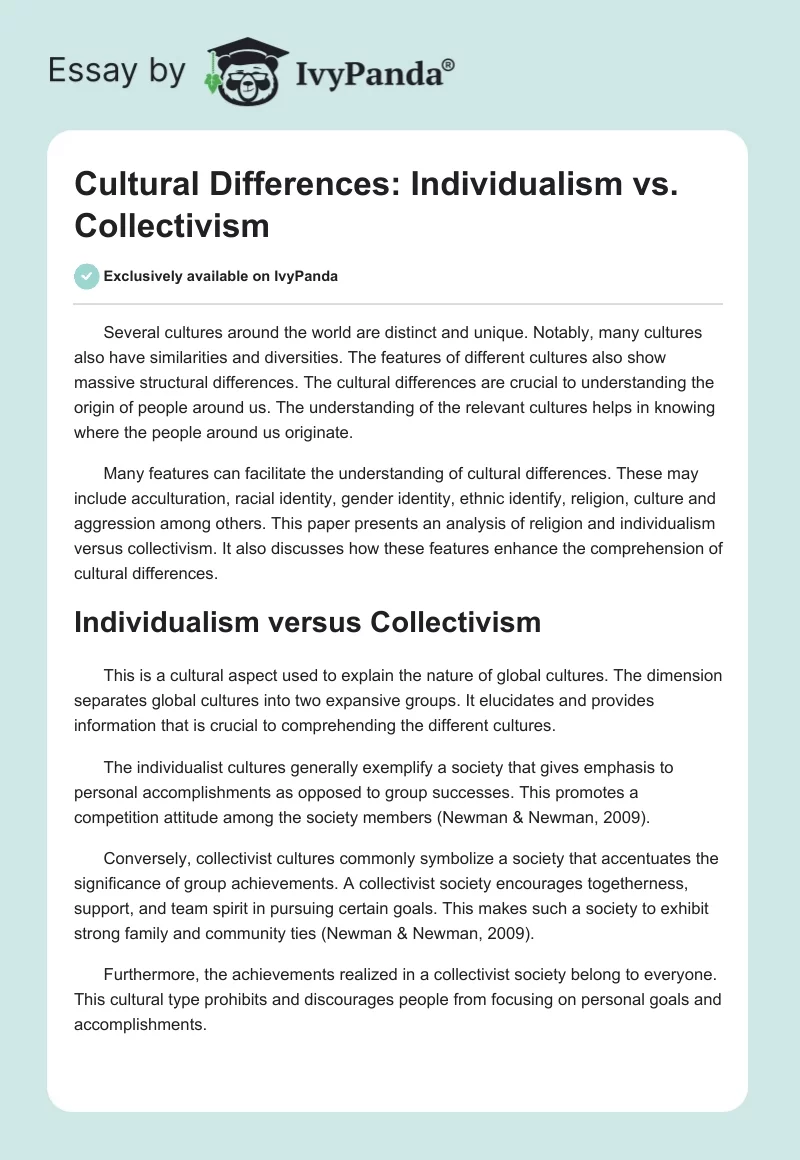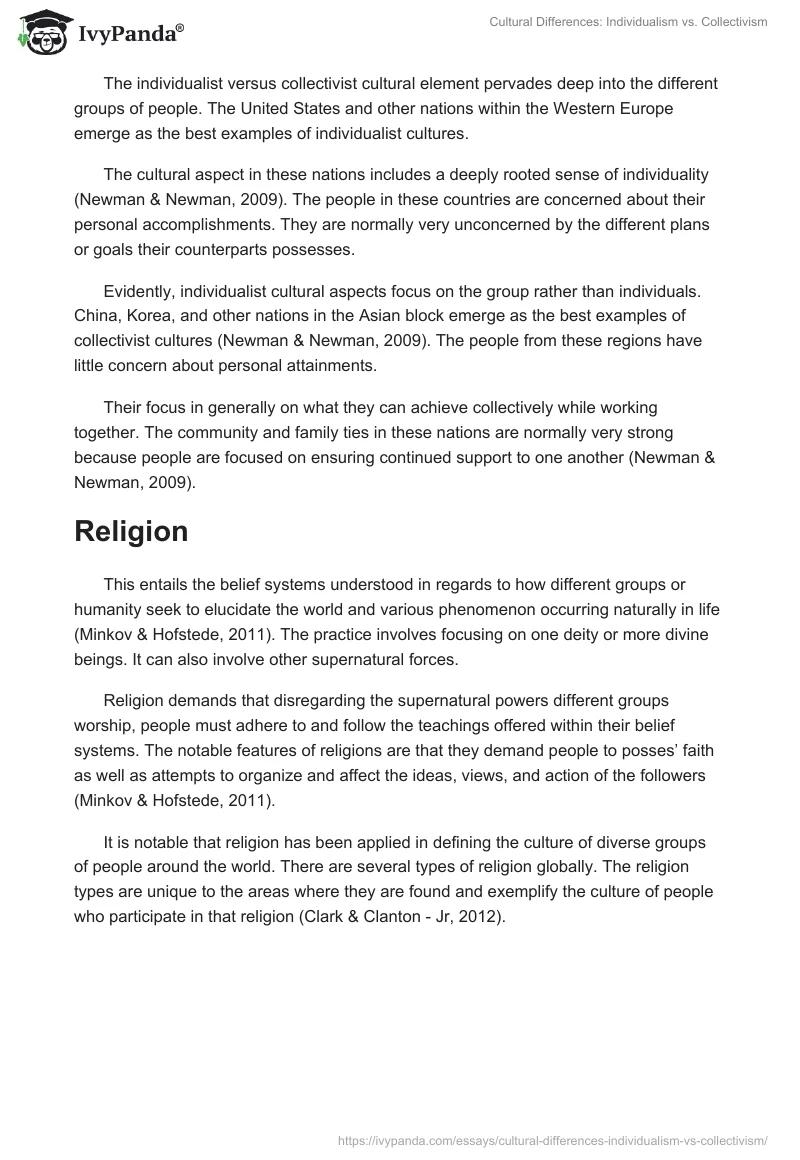Several cultures around the world are distinct and unique. Notably, many cultures also have similarities and diversities. The features of different cultures also show massive structural differences. The cultural differences are crucial to understanding the origin of people around us. The understanding of the relevant cultures helps in knowing where the people around us originate.
Many features can facilitate the understanding of cultural differences. These may include acculturation, racial identity, gender identity, ethnic identify, religion, culture and aggression among others. This paper presents an analysis of religion and individualism versus collectivism. It also discusses how these features enhance the comprehension of cultural differences.
Individualism versus Collectivism
This is a cultural aspect used to explain the nature of global cultures. The dimension separates global cultures into two expansive groups. It elucidates and provides information that is crucial to comprehending the different cultures.
The individualist cultures generally exemplify a society that gives emphasis to personal accomplishments as opposed to group successes. This promotes a competition attitude among the society members (Newman & Newman, 2009).
Conversely, collectivist cultures commonly symbolize a society that accentuates the significance of group achievements. A collectivist society encourages togetherness, support, and team spirit in pursuing certain goals. This makes such a society to exhibit strong family and community ties (Newman & Newman, 2009).
Furthermore, the achievements realized in a collectivist society belong to everyone. This cultural type prohibits and discourages people from focusing on personal goals and accomplishments.
The individualist versus collectivist cultural element pervades deep into the different groups of people. The United States and other nations within the Western Europe emerge as the best examples of individualist cultures.
The cultural aspect in these nations includes a deeply rooted sense of individuality (Newman & Newman, 2009). The people in these countries are concerned about their personal accomplishments. They are normally very unconcerned by the different plans or goals their counterparts possesses.
Evidently, individualist cultural aspects focus on the group rather than individuals. China, Korea, and other nations in the Asian block emerge as the best examples of collectivist cultures (Newman & Newman, 2009). The people from these regions have little concern about personal attainments.
Their focus in generally on what they can achieve collectively while working together. The community and family ties in these nations are normally very strong because people are focused on ensuring continued support to one another (Newman & Newman, 2009).
Religion
This entails the belief systems understood in regards to how different groups or humanity seek to elucidate the world and various phenomenon occurring naturally in life (Minkov & Hofstede, 2011). The practice involves focusing on one deity or more divine beings. It can also involve other supernatural forces.
Religion demands that disregarding the supernatural powers different groups worship, people must adhere to and follow the teachings offered within their belief systems. The notable features of religions are that they demand people to posses’ faith as well as attempts to organize and affect the ideas, views, and action of the followers (Minkov & Hofstede, 2011).
It is notable that religion has been applied in defining the culture of diverse groups of people around the world. There are several types of religion globally. The religion types are unique to the areas where they are found and exemplify the culture of people who participate in that religion (Clark & Clanton – Jr, 2012).
Significance of Individualism versus Collectivism in Understanding Cultural Differences
It is notable that Asian countries such as India, Japan, Korea, China and Singapore have a collectivist culture (Newman & Newman, 2009). Collectivist cultures observe economic expansion as a group effort where everyone must contribute. The Chinese Confucianism tradition values their people who exhibit characteristics of a community man. The people who emerge as social personalities in China are highly valued.
There is also the argument that individualists emanate from the cold regions of the globe towards the arctic. This has greatly influenced their cultural difference particularly the mode of dressing. The individualists wear heavy clothing in order to avoid the cold (Newman & Newman, 2009).
Conversely, the collectivist communities exist around the equator where the environment is warm and hot. This also influences their dressing style. Many people from the equatorial regions dress loosely and thinly since the environment around them is normally warm.
The cultural dimension is crucial to understanding the differences in expression of identity. It is notable that in individualist communities’ people promotes the significance of self-expression. Americans express their identity using their cars and clothing (Millon, 2003).
The self-expression in collectivist cultures is not very strict. People normally tend assume appearances that are suitable for their social standing in the community. They avoid the different aspects of self-expression that make them exceptional as persons.
Furthermore, in the individualist cultures property is owned at personal level. This means that assets belong to the owner who is an individual (Millon, 2003). However, the collectivist societies view property as a communal asset.
Therefore, the whole village may own assets such as land and everyone has a right to use the communal property (Newman & Newman, 2009). The expectations in adulthood also reveal additional cultural differences.
The individualist cultures expect people who have reached adulthood to exhibit characterizes self-sufficiency. The attributes for self-sufficiency may include setting and following personal objectives and work towards achieving social equity at the individual level.
Conversely, collectivist cultures expect adults to support their members and promote togetherness towards achieving goals (Newman & Newman, 2009). The adults are also anticipated to adhere to the traditional regulations governing the society or group.
Significance of Religion in Understanding Cultural Differences
It is notable the religion contributes massively to cultural differences. The different religion types such as “Protestant Roman Catholic, Orthodox, Confucian, and Buddhism” among others help in determining the culture differences of diverse regions (Minkov & Hofstede, 2011).
The cultural heritage and the teachings offered by diverse religion groups help in strengthening the culture of the groups that benefit from the teachings. Indeed, religion has remained significantly the same even with the emergence of globalization.
The learnt values contribute to the development of people (Minkov & Hofstede, 2011). Diverse religions develop varying values outside the mainstream of beliefs. It is notable that religion through denominations does not create a cultural change from the mainstream belief systems (Clark & Clanton – Jr, 2012).
For example, Christians have a belief system, which much as many denominations exist in the broad field of Christianity cannot change.
It is notable that religions emerge in already existing cultural foundations. This shows that religion cannot contribute to significant changes within the different cultural groups (Minkov & Hofstede, 2011).
The notion that many other indigenous groups of people have not started practicing any form belief system confirms that cultural differences exist even without religion. For example, the groups of indigenous people living in the Amazon basin and has very strong cultural affiliation have remained the same (Minkov & Hofstede, 2011).
References
Clark, T., & Clanton – Jr, D. (2012). Understanding Religion and Popular Culture. New York, NY: Routledge.
Millon, T. (2003). Handbook of psychology. Hoboken, NJ: Wiley.
Minkov, M., & Hofstede, G. H. (2011). Cultural differences in a globalizing world. Bingley, UK: Emerald.
Newman, B. M., & Newman, P. R. (2009). Development through life: A psychosocial approach. Australia: Wadsworth/Cengage Learning.


